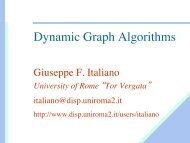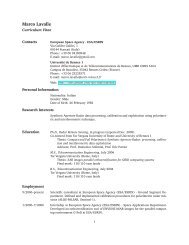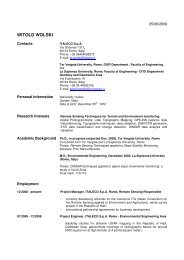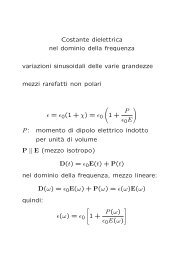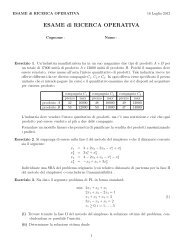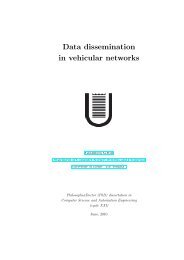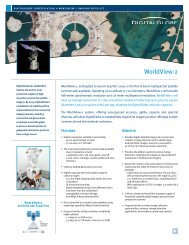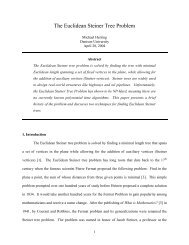TOR VERGATA UNIVERSITY UNSUPERVISED CLASSIFICATION ...
TOR VERGATA UNIVERSITY UNSUPERVISED CLASSIFICATION ...
TOR VERGATA UNIVERSITY UNSUPERVISED CLASSIFICATION ...
You also want an ePaper? Increase the reach of your titles
YUMPU automatically turns print PDFs into web optimized ePapers that Google loves.
Chapter 1 29<br />
where i, j are the gray tones in the windows, which are also the coordinates of the<br />
co-occurrence matrix space, while p (i,j) are the normalized frequencies with which<br />
two neighboring resolution cells separated by a fixed shift occur on the image, one<br />
with gray tone i and the other with gray tone j; N is the dimension of the co-<br />
occurrence matrix, which has a gray value range of the original image.<br />
1.5.2 Shape analysis: segmentation<br />
One way to introduce this additional information is to segment the image before the<br />
classification [152]. The segmentation produces regions which are more<br />
homogeneous in themselves than with nearby regions and represent discrete objects<br />
or areas in the image. After segmentation, each image region becomes a unit<br />
analysis for which a number of features, on top of spectral features, can be<br />
measured and used during the classification [153], [154], [155]. A large variety of<br />
segmentation algorithms were developed in these last twenty years [156], [157].<br />
Segmentation algorithms can conveniently be classified as boundary-based and<br />
region-based [156], [158], [159], [160]. Boundary-based algorithms detect object<br />
contours explicitly by using the discontinuity property; region-based algorithms<br />
locate object areas explicitly according to the similarity property [156].<br />
The boundary approach gathers the edge detection techniques. These methods do<br />
not lead directly to a segmentation of the image because contours obtained are<br />
seldom closed; therefore, it is necessary to carry out closing edges algorithm if one<br />
wishes a complete segmentation of the image. Indeed, after contours closing, the<br />
duality contours/regions appears clearly. A region is defined as the inside of a<br />
closed line. On the other hand, the methods of the region approach lead directly to<br />
a segmentation of the image, each pixel being assigned to a single region [161].





